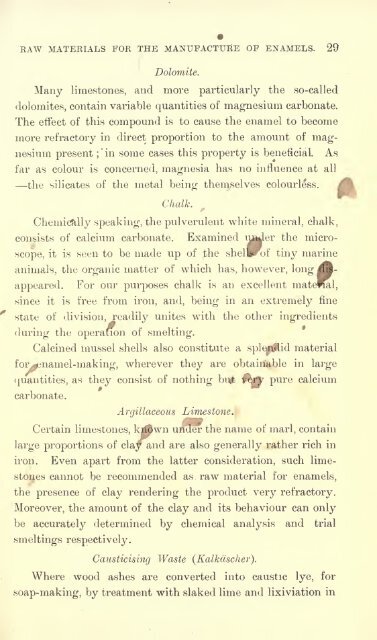Enamels and enamelling; an introduction to the preparation and ...
Enamels and enamelling; an introduction to the preparation and ...
Enamels and enamelling; an introduction to the preparation and ...
You also want an ePaper? Increase the reach of your titles
YUMPU automatically turns print PDFs into web optimized ePapers that Google loves.
RAW MATERIALS FOR THE MANUFACTURE OF ENAMELS. 29<br />
Dolomite.<br />
M<strong>an</strong>y limes<strong>to</strong>nes, <strong><strong>an</strong>d</strong> more particularly <strong>the</strong> so-called<br />
dolomites, contain variable qu<strong>an</strong>tities of magnesium carbonate.<br />
The effect of this compound is <strong>to</strong> cause <strong>the</strong> enamel <strong>to</strong> become<br />
more refrac<strong>to</strong>ry in direct proportion <strong>to</strong> <strong>the</strong> amount of mag-<br />
nesium present ;<br />
'<br />
in some cases this property is beneficial. As<br />
far as colour is concerned, magnesia has no influence at all<br />
<strong>the</strong> silicates of <strong>the</strong> metal being <strong>the</strong>mselves colourless. AL<br />
Chalk.<br />
Chemically speaking, <strong>the</strong> pulverulent white mineral, chalk,<br />
consists of calcium carbonate. Examined imJer <strong>the</strong> micro-<br />
scope, it is seen <strong>to</strong> be made up of <strong>the</strong> shel^of tiny marine<br />
<strong>an</strong>imals, <strong>the</strong> org<strong>an</strong>ic matter of which has, however, long A-<br />
appeared. For our purposes chalk is <strong>an</strong> excellent mateKal,<br />
since it is free from iron, <strong><strong>an</strong>d</strong>, being in <strong>an</strong> extremely fine<br />
state of division, readily unites with <strong>the</strong> o<strong>the</strong>r ingredients<br />
during <strong>the</strong> operauon of smelting.<br />
Calcined mussel shells also constitute a sple^jlid material<br />
for^snamel-making, wherever <strong>the</strong>y are obtainable in large<br />
qu<strong>an</strong>tities, as <strong>the</strong>y consist of nothing bu4 ^1f Pure calcium<br />
carbonate.<br />
Argillaceous Limes<strong>to</strong>ne.<br />
Certain limes<strong>to</strong>nes, kj^wn unoer <strong>the</strong> name of marl, contain<br />
large proportions of clay<strong><strong>an</strong>d</strong> are also generally ra<strong>the</strong>r rich in<br />
iron. Even apart from <strong>the</strong> latter consideration, such lime-<br />
s<strong>to</strong>nes c<strong>an</strong>not be recommended as raw material for enamels,<br />
<strong>the</strong> presence of clay rendering <strong>the</strong> product very refrac<strong>to</strong>ry.<br />
Moreover, <strong>the</strong> amount of <strong>the</strong> clay <strong><strong>an</strong>d</strong> its behaviour c<strong>an</strong> only<br />
be accurately determined by chemical <strong>an</strong>alysis <strong><strong>an</strong>d</strong> trial<br />
smeltings respectively.<br />
Causticising Waste (Kalkdscher).<br />
Where wood ashes are converted in<strong>to</strong> caustic lye, for<br />
soap-making, by treatment with slaked lime <strong><strong>an</strong>d</strong> lixiviation in
















